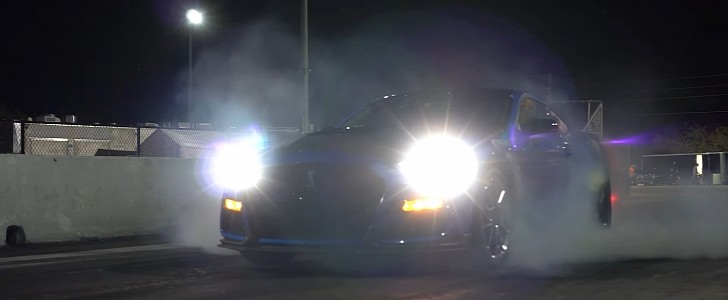Modifying an already potent and competent sports car isn’t easy. Money can buy parts and labor, but passion and effort are needed in the pursuit of making those aftermarket parts work better than the bone-stock setup. Palm Beach Dyno, for example, has spent more than a year developing their tuning program for the most badass 'Stang of them all, the GT500.
Lovingly called PBD CX1100, the muscled-up pony in the following video is a development vehicle capable of 9.3 seconds on the quarter-mile sprint. For reference, Ford quotes 10.7 seconds while Motor Trend couldn’t do better than 11.3 clicks during their first contact with a press car.
What really boggles the mind is the PBD CX1100 crossing the line at 155 miles per hour, the equivalent to 250 kilometers per hour for our European readers. Speaking of the Old Continent, that’s also the speed limit German automakers are electronically enforcing in Autobahn cruisers. Believe it or not, even the BMW M340i xDrive sports sedan is artificially limited to 155 MPH although it boasts 382 horsepower and 369 pound-feet (500 Nm) of torque.
“Every time we take our 2020 Shelby GT500 to the track, it goes quicker and quicker,” said Palm Beach Dyno founder Ken Bjonnes. “155 MPH with this setup is much better than we expected. Next up [on the modifications list] will be an ice tank to take care of the blower heat. And next up, 160 MPH.”
As the name implies, the purpose of an ice tank is to improve heat dissipation. Adding ice to the intercooler chills the air charge temperature as it enters the intake path, and as you know from the laws of physics, cooler air is denser air and, therefore, produces bigger bangs in an ICE application.
In addition to a re-mapped ECU, the PBD CX1100 flexes larger injectors, high-quality headers from Kooks, a ported blower with a billet lid from Jokers Performance, a more aggressive pulley, drag radials, and so forth.
From a visual standpoint, the most obvious changes over the factory-standard car would be the Forgeline rear wheels, carbon-fiber seats, and Anderson Composites carbon-fiber rear spoiler and hood. The latter are currently listed at $899.10 and $1,439.10, including shipping.
What really boggles the mind is the PBD CX1100 crossing the line at 155 miles per hour, the equivalent to 250 kilometers per hour for our European readers. Speaking of the Old Continent, that’s also the speed limit German automakers are electronically enforcing in Autobahn cruisers. Believe it or not, even the BMW M340i xDrive sports sedan is artificially limited to 155 MPH although it boasts 382 horsepower and 369 pound-feet (500 Nm) of torque.
“Every time we take our 2020 Shelby GT500 to the track, it goes quicker and quicker,” said Palm Beach Dyno founder Ken Bjonnes. “155 MPH with this setup is much better than we expected. Next up [on the modifications list] will be an ice tank to take care of the blower heat. And next up, 160 MPH.”
As the name implies, the purpose of an ice tank is to improve heat dissipation. Adding ice to the intercooler chills the air charge temperature as it enters the intake path, and as you know from the laws of physics, cooler air is denser air and, therefore, produces bigger bangs in an ICE application.
In addition to a re-mapped ECU, the PBD CX1100 flexes larger injectors, high-quality headers from Kooks, a ported blower with a billet lid from Jokers Performance, a more aggressive pulley, drag radials, and so forth.
From a visual standpoint, the most obvious changes over the factory-standard car would be the Forgeline rear wheels, carbon-fiber seats, and Anderson Composites carbon-fiber rear spoiler and hood. The latter are currently listed at $899.10 and $1,439.10, including shipping.














